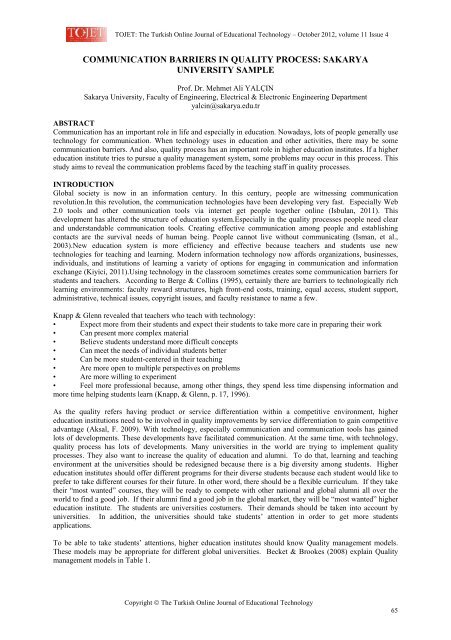october 2012 - TOJET the Turkish online journal of educational ...
october 2012 - TOJET the Turkish online journal of educational ...
october 2012 - TOJET the Turkish online journal of educational ...
Create successful ePaper yourself
Turn your PDF publications into a flip-book with our unique Google optimized e-Paper software.
<strong>TOJET</strong>: The <strong>Turkish</strong> Online Journal <strong>of</strong> Educational Technology – October <strong>2012</strong>, volume 11 Issue 4<br />
COMMUNICATION BARRIERS IN QUALITY PROCESS: SAKARYA<br />
UNIVERSITY SAMPLE<br />
Pr<strong>of</strong>. Dr. Mehmet Ali YALÇIN<br />
Sakarya University, Faculty <strong>of</strong> Engineering, Electrical & Electronic Engineering Department<br />
yalcin@sakarya.edu.tr<br />
ABSTRACT<br />
Communication has an important role in life and especially in education. Nowadays, lots <strong>of</strong> people generally use<br />
technology for communication. When technology uses in education and o<strong>the</strong>r activities, <strong>the</strong>re may be some<br />
communication barriers. And also, quality process has an important role in higher education institutes. If a higher<br />
education institute tries to pursue a quality management system, some problems may occur in this process. This<br />
study aims to reveal <strong>the</strong> communication problems faced by <strong>the</strong> teaching staff in quality processes.<br />
INTRODUCTION<br />
Global society is now in an information century. In this century, people are witnessing communication<br />
revolution.In this revolution, <strong>the</strong> communication technologies have been developing very fast. Especially Web<br />
2.0 tools and o<strong>the</strong>r communication tools via internet get people toge<strong>the</strong>r <strong>online</strong> (Isbulan, 2011). This<br />
development has altered <strong>the</strong> structure <strong>of</strong> education system.Especially in <strong>the</strong> quality processes people need clear<br />
and understandable communication tools. Creating effective communication among people and establishing<br />
contacts are <strong>the</strong> survival needs <strong>of</strong> human being. People cannot live without communicating (Isman, et al.,<br />
2003).New education system is more efficiency and effective because teachers and students use new<br />
technologies for teaching and learning. Modern information technology now affords organizations, businesses,<br />
individuals, and institutions <strong>of</strong> learning a variety <strong>of</strong> options for engaging in communication and information<br />
exchange (Kiyici, 2011).Using technology in <strong>the</strong> classroom sometimes creates some communication barriers for<br />
students and teachers. According to Berge & Collins (1995), certainly <strong>the</strong>re are barriers to technologically rich<br />
learning environments: faculty reward structures, high front-end costs, training, equal access, student support,<br />
administrative, technical issues, copyright issues, and faculty resistance to name a few.<br />
Knapp & Glenn revealed that teachers who teach with technology:<br />
• Expect more from <strong>the</strong>ir students and expect <strong>the</strong>ir students to take more care in preparing <strong>the</strong>ir work<br />
• Can present more complex material<br />
• Believe students understand more difficult concepts<br />
• Can meet <strong>the</strong> needs <strong>of</strong> individual students better<br />
• Can be more student-centered in <strong>the</strong>ir teaching<br />
• Are more open to multiple perspectives on problems<br />
• Are more willing to experiment<br />
• Feel more pr<strong>of</strong>essional because, among o<strong>the</strong>r things, <strong>the</strong>y spend less time dispensing information and<br />
more time helping students learn (Knapp, & Glenn, p. 17, 1996).<br />
As <strong>the</strong> quality refers having product or service differentiation within a competitive environment, higher<br />
education institutions need to be involved in quality improvements by service differentiation to gain competitive<br />
advantage (Aksal, F. 2009). With technology, especially communication and communication tools has gained<br />
lots <strong>of</strong> developments. These developments have facilitated communication. At <strong>the</strong> same time, with technology,<br />
quality process has lots <strong>of</strong> developments. Many universities in <strong>the</strong> world are trying to implement quality<br />
processes. They also want to increase <strong>the</strong> quality <strong>of</strong> education and alumni. To do that, learning and teaching<br />
environment at <strong>the</strong> universities should be redesigned because <strong>the</strong>re is a big diversity among students. Higher<br />
education institutes should <strong>of</strong>fer different programs for <strong>the</strong>ir diverse students because each student would like to<br />
prefer to take different courses for <strong>the</strong>ir future. In o<strong>the</strong>r word, <strong>the</strong>re should be a flexible curriculum. If <strong>the</strong>y take<br />
<strong>the</strong>ir “most wanted” courses, <strong>the</strong>y will be ready to compete with o<strong>the</strong>r national and global alumni all over <strong>the</strong><br />
world to find a good job. If <strong>the</strong>ir alumni find a good job in <strong>the</strong> global market, <strong>the</strong>y will be “most wanted” higher<br />
education institute. The students are universities costumers. Their demands should be taken into account by<br />
universities. In addition, <strong>the</strong> universities should take students’ attention in order to get more students<br />
applications.<br />
To be able to take students’ attentions, higher education institutes should know Quality management models.<br />
These models may be appropriate for different global universities. Becket & Brookes (2008) explain Quality<br />
management models in Table 1.<br />
Copyright © The <strong>Turkish</strong> Online Journal <strong>of</strong> Educational Technology<br />
65
















